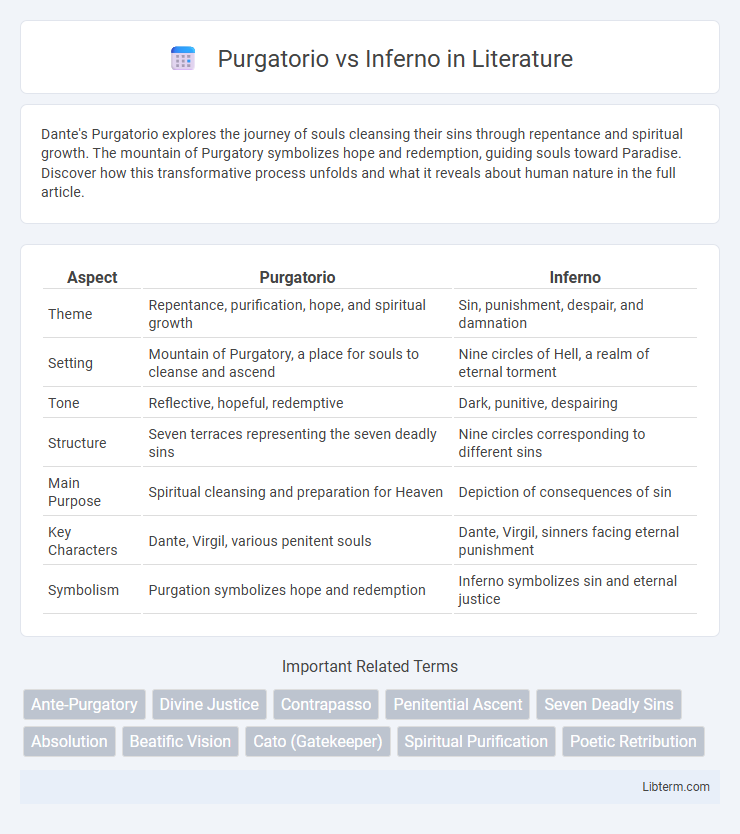Dante's Purgatorio explores the journey of souls cleansing their sins through repentance and spiritual growth. The mountain of Purgatory symbolizes hope and redemption, guiding souls toward Paradise. Discover how this transformative process unfolds and what it reveals about human nature in the full article.
Table of Comparison
| Aspect | Purgatorio | Inferno |
|---|---|---|
| Theme | Repentance, purification, hope, and spiritual growth | Sin, punishment, despair, and damnation |
| Setting | Mountain of Purgatory, a place for souls to cleanse and ascend | Nine circles of Hell, a realm of eternal torment |
| Tone | Reflective, hopeful, redemptive | Dark, punitive, despairing |
| Structure | Seven terraces representing the seven deadly sins | Nine circles corresponding to different sins |
| Main Purpose | Spiritual cleansing and preparation for Heaven | Depiction of consequences of sin |
| Key Characters | Dante, Virgil, various penitent souls | Dante, Virgil, sinners facing eternal punishment |
| Symbolism | Purgation symbolizes hope and redemption | Inferno symbolizes sin and eternal justice |
Introduction to Dante’s Divine Comedy
Dante's Divine Comedy consists of three parts: Inferno, Purgatorio, and Paradiso, each representing a different stage of the soul's journey toward God. Inferno depicts the descent into Hell, illustrating the consequences of sin through vivid punishments, while Purgatorio portrays the purification process as souls ascend Mount Purgatory to achieve redemption. These contrasting sections highlight themes of justice and mercy central to Dante's medieval worldview and literary masterpiece.
Overview: Inferno and Purgatorio Explained
Inferno depicts Dante's journey through Hell, illustrating the consequences of sin through nine circles of increasing punishment severity, each tailored to specific transgressions. Purgatorio follows as a realm of purification, where souls undergo penance to cleanse their sins before ascending to Paradise, structured across seven terraces representing the seven deadly sins. Both canticles highlight moral justice and spiritual progression, with Inferno emphasizing divine retribution and Purgatorio focusing on redemption and hope.
Setting and Structure: Contrasts Between Realms
Purgatorio is depicted as a mountainous island with seven terraces, each representing a specific sin with souls undergoing purification, contrasting sharply with Inferno's nine concentric circles, each embodying different sins with corresponding eternal punishments. The ascending structure of Purgatorio symbolizes spiritual progress and hope, while Inferno's descending layers emphasize despair and irrevocable damnation. The physical settings reflect the moral states within Dante Alighieri's Divine Comedy, highlighting the journey from suffering toward redemption versus irreversible condemnation.
Symbolism in Inferno vs. Purgatorio
Inferno uses dark, chaotic imagery and grotesque punishments to symbolize eternal sin and divine wrath, emphasizing despair and spiritual death. Purgatorio presents a more orderly, ascending structure where sufferings purify souls, symbolizing hope, repentance, and the soul's journey toward salvation. The contrasting symbolism highlights Inferno's emphasis on condemnation and Purgatorio's focus on redemption and spiritual growth.
Thematic Differences: Sin and Redemption
Purgatorio emphasizes the theme of redemption through the process of purification and penance, where souls actively work to cleanse themselves of sin and progress toward salvation. Inferno portrays sin as a permanent state of moral corruption, with sinners enduring eternal punishment reflecting the nature and severity of their transgressions. The contrast highlights Purgatorio's hopeful path of transformation versus Inferno's depiction of irrevocable damnation.
Depiction of Sinners and Penitents
Purgatorio portrays sinners as penitents undergoing purification through suffering and spiritual growth, emphasizing hope and redemption. Inferno depicts sinners as irrevocably damned, suffering eternal punishment tailored to the nature of their sins, highlighting justice and retribution. The contrasting depictions underline Purgatorio's focus on repentance and eventual salvation, while Inferno stresses eternal condemnation and moral consequences.
Dante’s Personal Journey: Fear vs. Hope
Dante's journey through Inferno embodies a confrontation with fear, as he witnesses the consequences of sin and despair in Hell's torment. In Purgatorio, this fear evolves into hope, reflecting a path of purification and redemption where souls strive for forgiveness. The transition illustrates Dante's personal transformation from despair to spiritual renewal, emphasizing the human potential for change and salvation.
Key Characters in Inferno and Purgatorio
Inferno, the first part of Dante's Divine Comedy, features key characters such as Virgil, who guides Dante through Hell, and iconic sinners like Paolo and Francesca, who symbolize tragic love in the circle of the lustful. Purgatorio, the second part, introduces Statius, a poet and convert, alongside souls undergoing purification to ascend to Heaven, emphasizing themes of repentance and hope. The contrast between the eternal punishment in Inferno and the hopeful cleansing in Purgatorio highlights differing portrayals of sin and redemption through these pivotal figures.
Narrative Tone and Imagery Comparison
Purgatorio's narrative tone is contemplative and hopeful, emphasizing redemption through vivid imagery of cleansing fires and ascending mountain terraces, symbolizing spiritual purification. Inferno contrasts sharply with a harsh, relentless tone, presenting nightmarish, grotesque imagery of eternal damnation in dark, fiery pits and monstrous tortures that evoke fear and despair. The shift from Inferno's oppressive atmosphere to Purgatorio's light-infused, transformative landscapes underscores Dante's thematic progression from punishment to salvation.
Moral Lessons: Lessons from Hell and Purgatory
Inferno teaches the consequences of unrepented sin through vivid depictions of eternal punishment, emphasizing the importance of moral choices and justice. Purgatorio illustrates the process of purification and redemption, highlighting hope, penance, and the potential for spiritual growth. Together, these realms offer a comprehensive moral framework emphasizing accountability, transformation, and divine mercy.
Purgatorio Infographic

 libterm.com
libterm.com